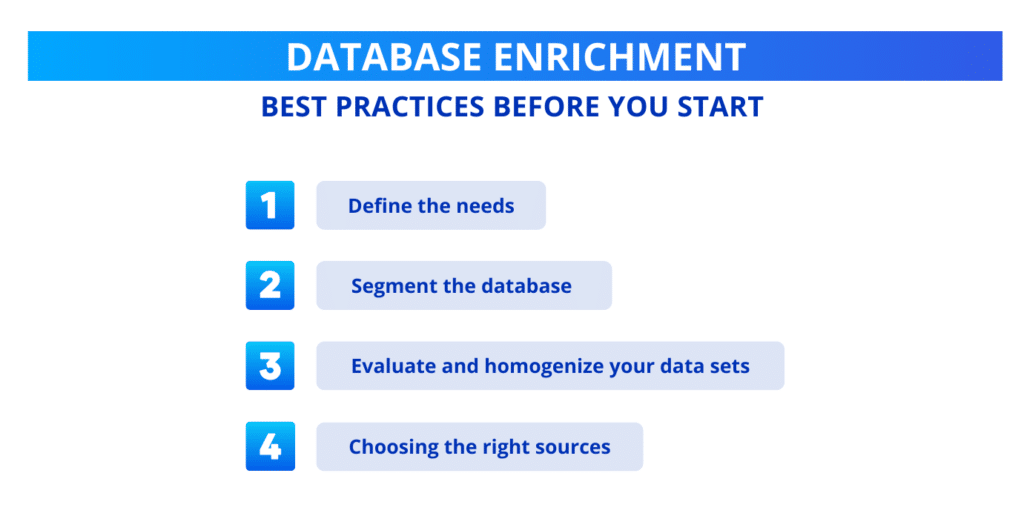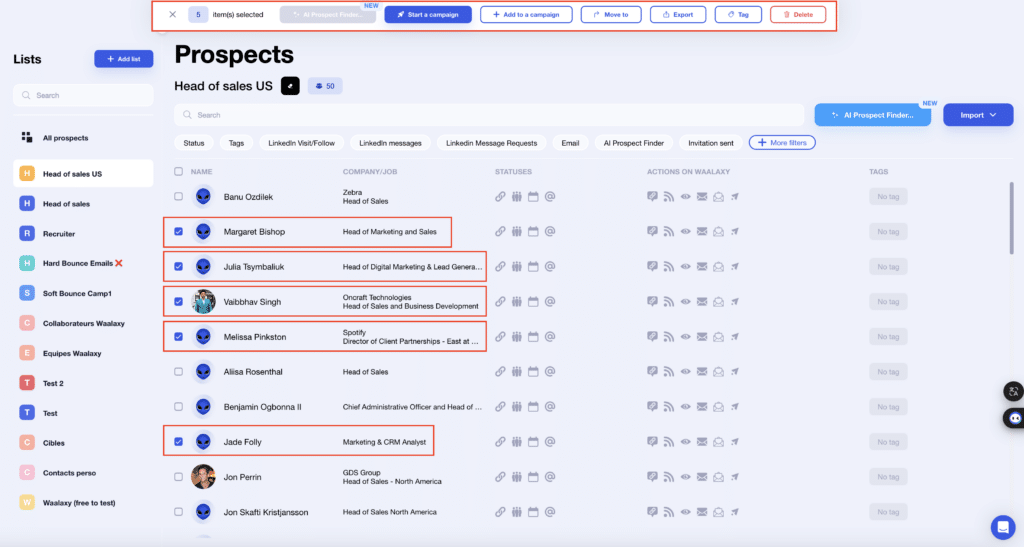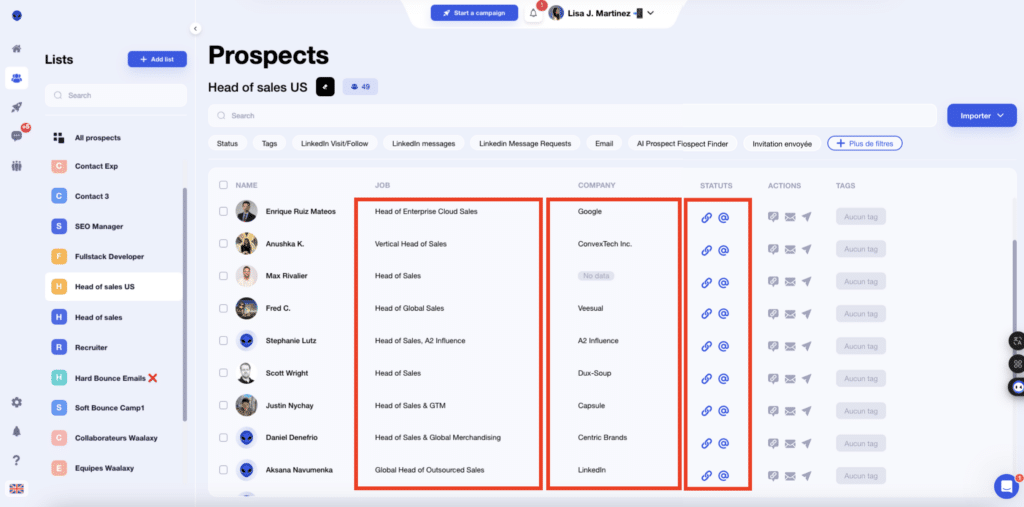Today, data is the new black gold. 🕋 But a raw database is a bit like digging without a plan: you risk missing the nuggets and collecting nothing but dust!
Precisely, data enrichment is like a super-powerful metal detector, stepping in to transform your information into a treasure trove of opportunities at your fingertips. 🤩
Behind this somewhat technical term, the idea is simple 💡: enhance and supplement your contacts’ data with valuable, up-to-date information, to boost performance.
And, whether you’re looking to improve the results of your marketing campaigns, refine your sales strategies or simply better understand your customers… 👇🏼
🔑 We explain why data enrichment is the key to generating more opportunities, and how to enrich the data effectively. ➡️ On the program:
- Definition of data enrichment.
- Best practices before getting started with database enrichment.
- Where can I find the enrichment data?
- Enrichment data to be retrieved from LinkedIn.
- Why is enriching the LinkedIn database a great idea?
- What tools to easily enrich my data?
So, are you ready to dig for the hidden value in your data and enrich your databases to maximize their potential? 😎 Let’s get started!
What is Data Enrichment?
💎 Data enrichment, consists of enhancing existing information by collecting and adding additional data, via various sources (thanks to data scraping) :
- Contact details,
- Demographic or Firmographic data,
- Website data,
- Legal data,
- Technologies used,
- Associated contacts,
- etc.
The aim is to make your databases more complete, accurate and reliable, so as to maximize their value to the company. 🎯 This process helps to improve analyses, refine decisions and marketing strategies, based on reliable data.
As part of prospecting, database enrichment makes it possible to better target prospects and personalize future exchanges, by adding information such as phone number, email address, location…
Data enrichment can be carried out manually or using automated tools that exploit external databases, social networks and APIs. ⚙️
But, before you get started, we have a few best practices to share with you. 🚨
Before Getting Started with Data Enrichment
To enrich your databases, it’s essential to follow certain best practices to maximize the efficiency and relevance of the information obtained ✅ :

- Precisely define your needs and the additional data you require, to better target the sources and enrichment tools to use. What are you looking for: e-mails, phone numbers, social network information…?
- Segment the database to ensure that the data added is relevant to each group. Before enrichment, divide your database into coherent segments according to your criteria (company size, sector of activity or position held…).
- Evaluate and standardize your data sets: your prospecting database must be clean and standardized (date formats, telephone numbers, etc.). This avoids duplication, re-sorting and errors after enrichment.
- Choose the right sources: use reliable sources to obtain up-to-date and accurate data, in compliance with the RGPD.
And, precisely, we help you prepare your data enrichment, with a list of sources, where you can harvest reliable enrichment data. 🔥
List of Data Enrichment Sources
👇🏼 Here are the different data enrichment sources you can use, depending on your needs:
- Social networks (LinkedIn, Facebook, Instagram, etc.) 📲: LinkedIn & Facebook groups are very effective for enriching B2B data. Instagram ise more useful for B2C, targeting user interests and behaviors.
- Search engines (Google) 🔍: Search engines enable you to find additional information on companies, contacts or specific topics by consulting websites, blogs, articles or press releases.
- External databases 📋: Specialized platforms such as ZoomInfo or Clearbit offer B2B databases containing information on companies and their employees (not recommended, as data is most often not up to date).
- API ⚙️: Numerous data enrichment APIs are integrated into certain prospecting tools and automate the collection of information from multiple sources in real time, improving data accuracy and updating.
- Professional directories 📚 such as Kompass or Yellow Pages give access to detailed information on companies (website, SIRET/SIREN…), useful for enriching data, but difficult to automate.
These sources can vary in quality and must be selected according to the relevance of the information sought and the type of campaign.
For a B2B campaign and information, LinkedIn remains the best source of information to use, but to harvest and enrich what data exactly? 🧐 That’s immediately obvious.
List of enrichment data to retrieve from LinkedIn
👇🏼 Here are the main data to retrieve from LinkedIn to enrich a database 👤 :
- First and last name: Basic information to identify the contact.
- Professional title: To target the right people and identify a hierarchical position (decision-makers, managers, etc.), especially in a B2B strategy.
- Profile URL: Create a link to the person’s LinkedIn profile, for future reference or quick verification of information. Ideal for quick follow-up and updating your database.
- Company: To understand where the person works and their professional environment.
- Industry: To segment prospects by industry and run targeted campaigns.
- Geographical location: To tailor campaigns to specific geographical areas or organize local meetings.
- Website: For direct access and an overview of the organization, its products/services, values and communications.
- Contact details :
- Professional e-mail address: often the most sought-after data for direct contact or follow-up.
- Business telephone number: enables direct, personal contact, useful for faster, more engaging follow-up (if available).
This data must be hunted down and collected with LinkedIn data enrichment, to target and personalize your actions (sales prospecting or recruitment). 🔫
Why Database enrichment?
Database enrichment enables us to better understand and speak to our target audience. 📣 But that’s not all!
Here’s a summary of why you should use data enrichment:
- ⏳ Time savings: for building your marketing automation campaigns as well as for your sales teams in preparing their exchanges with customers.
- 🧠 Better audience segmentation and understanding of needs, but also better personalization of offers to meet customer expectations.
- 💎 Increased qualification of the prospect file, reducing wasted effort and improving the profitability of sales actions.
- 📊 Improved conversion rate, relevance and effectiveness of marketing and sales strategies.
Finally, we particularly recommend using data enrichment and taking advantage of these benefits, for the following steps 👇🏼 :
- Update an existing CRM database.
- Carry out multichannel campaigns: LinkedIn prospecting messages, Cold Email and Calling.
- Improve campaign results.
We’ll give you an overview of these steps without and with enrichment, so you can clearly see the difference and demonstrate the effectiveness of database enrichment. 💥
To Update your CRM Database
Database enrichment keeps your CRM reliable and relevant, filled with qualified contacts ready for use! 🙌🏼
🔄 This regular update enables :
- Guarantee that customer data enrichment (contact details, job title, company…) is always correct,
- Avoid having to work with obsolete data that could adversely affect the quality of interactions.
- Boost the productivity of sales and marketing teams, and improve customer satisfaction.
- Improve the ability to segment effectively, personalize messages and precisely target prospects.
👇🏼 Here’s an example of a CRM database, WITHOUT enrichment:

- ❌ Job titles that don’t match marketing targeting.
- ❌ Titles and company mixed up.
- ❌ No contact information: no website and no email enrichment.
👇🏼 And, here’s an example of a good CRM data enrichment:

- ✅ LinkedIn job titles (or job titles) that match perfectly the target (and that’s regardless of language).
- ✅ Well-identified company names (if data available).
- ✅ Contact information present: website and email (in addition to LinkedIn profile URL, present by default).
To sum up, using dataenrichment to update your CRM data, allows you to launch ultra-efficient personalized multichannel campaigns! 🚀
To Carry Out Multichannel Campaigns
Data enrichment is highly effective for personalizing your multichannel campaigns with accurate, relevant prospect information. 🎨
By knowing their position, industry, company, interests, etc. ✨ You can:
- Segment your audiences and create messages tailored to each acquisition channel (e-mail, social networks, SMS).
- Tailor your messages to specifically address their needs and issues.
- Make your communications more targeted, engaging and credible, increasing your chances of capturing their attention.
- Establish a more authentic relationship and reinforce prospect engagement to improve open rates, response rates and conversion rates.
👇🏼 For proof, here are two examples, of a LinkedIn message and a prospecting email 💬, WITHOUT data enrichment:


Consequence? 😞 Without prior database enrichment, these two messages will bring few results, as they are :
- ❌ Too generic, they could apply to any company/person
- ❌ Not personalized, which reduces their impact.
- ❌ There’s no call to action, which makes messages less engaging and doesn’t make it easy for the prospect to respond.
👇🏼 This time, here’s an example of a LinkedIn connect message, WITH data enrichment:


Consequence? 🏆 These messages, with data enrichment, are much more likely to “succeed” and therefore bring results because they are :
- ✅ Personalized and engaging thanks to variables (or dynamic tags).
- ✅ Clear call-to-actions with a direct link to a calendar, making it easy to book appointments.
- ✅ Professional, yet friendly tone and messages get straight to the point, respecting the prospect’s time and encouraging a response.
Now let’s take a look at how much you could boost your results with data enrichment. 🤑
To improve your KPIs
If you use data enrichment, you can automatically improve your campaign results! 🤖 Thanks to this additional data, you can:
- Better segment your audiences, personalize your messages and target more effectively.
- Also improve the overall relevance and effectiveness of your marketing campaigns.
The result? 📊 The optimization of several sales KPIs!
- Increased open, click and conversion rates,
- Reduced bounce rates.
- Increase prospect engagement.
- Optimized return on investment (ROI).
👇🏼 First, here’s an example of the results obtained after a campaign launched WITHOUT data enrichment:

👎🏼 Unfortunately, very few opportunities to convert prospects into customers will be generated by this campaign:
- ❌ Acceptance rate of only 25%.
- ❌ Response rate to LinkedIn messages of only 14%.
- ❌ Really tiny email response rate of 9%.
👇🏼 On the other hand, here’s an example of the results obtained (during the same campaign), WITH the data enrichment performed upstream 😎 :

And there you can see the difference in performance 🤩 :
- ✅ 31.7% acceptance rate (+6.7%).
- ✅ LinkedIn response rate of 66% (+52%).
- ✅ Email response rate 41% (+32%).
What is a good response rate?
👉🏼 LinkedIn messages: between 25 and 40%.
👉🏼 Email: between 20 and 30%.
Would you like to achieve the same results? You can, by using the right data enrichment tools. 🦾
Which Data Enrichment Tools To Use for ?
⚙️ Here are the main types of tools for data enrichment:
- Sales intelligence tools that provide in-depth data on companies, contacts and markets, useful for B2B prospecting. For example, LinkedIn Sales Navigator.
- Contact enrichers that fill in missing information on prospects (e-mails, phone numbers, position, etc.) by cross-referencing existing databases.
- Scraping tools that extract public data from websites and social networks to enrich your databases.
- Enrichment APIs: to automate real-time enrichment via external sources to update and complete data.
- Some CRM with integrated enrichment: to automatically keep contact information up to date.
These tools make data more complete, relevant and usable for more effective sales and marketing campaigns. 🔥
But, rather than having to select several tools… we suggest a single solution that brings all these tools and features together: it’s Waalaxy! 👽
Our tool automates data collection and enrichment, while remaining RGPD-compliant (thanks to integrations like Dropcontact) :
- Data scraping from LinkedIn,
- Contact enrichment with integrated import,
- Automation of multichannel and CRM campaigns,
- API and Business Intelligence,
- Email Finder and Phone Finder functionalities.

With Waalaxy, you’ll never again be short of data on your contacts and/or prospects. It’s the best tool you can use to enrich your databases 💥 Here’s why:
- It’s ultra-easy to use,
- It’s available as a freemium trial version,
- It provides the highest number of reliable results,
- It delivers them faster and more clearly,
- It integrates all enrichment functionalities to facilitate prospecting.
- Allows you to automate enrichment and include it in each of your campaigns.
- It allows you to sort and your marketing segmentation lists using the data collected.
🤩 What more can I say? You don’t have to do anything more, Waalaxy works for you. 🔥
You really can’t miss it! Try it now. 👇🏼
Conclusion – Waalaxy for Lead Data Enrichment
Enriching data is essential for maximizing the effectiveness of your sales/marketing actions and boosting the performance of your campaigns💥, whether for :
- Improve prospect segmentation,
- Personalize your messages,
- Or automatically synchronize information with your CRM tool.
🤖 Waalaxy not only automates prospecting on LinkedIn, but also automatically enriches your contacts with relevant data, for more effective multichannel campaigns.
This high-performance tool saves you time and, above all, increases your chances of turning leads into qualified customers.
If you’d like to find out more about the various enrichment tools, we’ve put together a comparison of the Seamless.ai & RocketReach enrichment tool with other alternatives such as Waalaxy, Apollo, Kaspr, Cognisim, Lusha…
Why wait to make the most of your data? It’s up to you! 🕹️
Frequently Asked Questions (FAQ)
🏁 To conclude, here are the answers to the most frequently asked questions on the subject. 👇🏼
B2B data enrichment with or without API?
Enriching a B2B database can be done with or without an API, depending on requirements and available resources. 🤔 But what difference does API integration make?
👉🏼 WITH data enrichment API integration to automate real-time updating and enrichment. 🤖
- Data is extracted directly from reliable external sources and automatically integrated into your CRM or data management system.
- This solution is ideal for companies looking to manage a large volume of data continuously, keep their database up to date and minimize manual tasks.
👉🏼 WITHOUT API integration, enrichment relies on manual or semi-automated methods. ✋🏼
- This includes using ad hoc enrichment tools or manually searching for information via platforms such as LinkedIn.
- Although less costly and simpler to set up, this process is slower and can result in obsolete data or human error.
The choice depends on the size of the company, the volume of data to be processed and the available budget. 💰
How to boost database performance?
🚀 To boost database performance, there are several best practices to follow:
- Regular cleaning and updating : Eliminate duplicates, correct errors and remove obsolete data for an accurate, usable database.
- Segmentation of data according to relevant criteria to target your marketing and sales actions, thus increasing their effectiveness.
- Data enrichment: Add additional information to get a more complete view of your contacts and better personalize your campaigns (as explained in the article).
- Automation: Use automation tools to enrich, cleanse and update the database in real time, reducing manual effort and ensuring an up-to-date database.
These actions optimize data quality and efficiency for better sales and marketing results. 💎
What are the risks of data enrichment?
There are a number of risks associated with data enrichment, and it is important to be aware of them in order to avoid errors or legal consequences ⚖️ :
- Breach of confidentiality (RGPD in 🇪🇺): Collecting or using personal data without explicit consent can result in severe penalties. It is therefore crucial to respect the rules and check the compliance of your data enrichment techniques.
- Data inaccuracy: If the sources used to enrich data are not reliable, you run the risk of integrating erroneous information, which can adversely affect the quality of prospecting plan, marketing or sales campaigns.
- Rapid data obsolescence: Data changes frequently (jobs, e-mails, etc.). If enrichment is not regular, the database can quickly become obsolete.
- Loss of reputation: Excessive data collection or misuse (spam) can damage a company’s reputation, affecting the relationship with prospects and customers.
🔐 Managing these risks means using reliable sources and complying with current legislation.
Now you know all about data enrichment! ✨ I wish you good enrichment and see you soon! 👽









